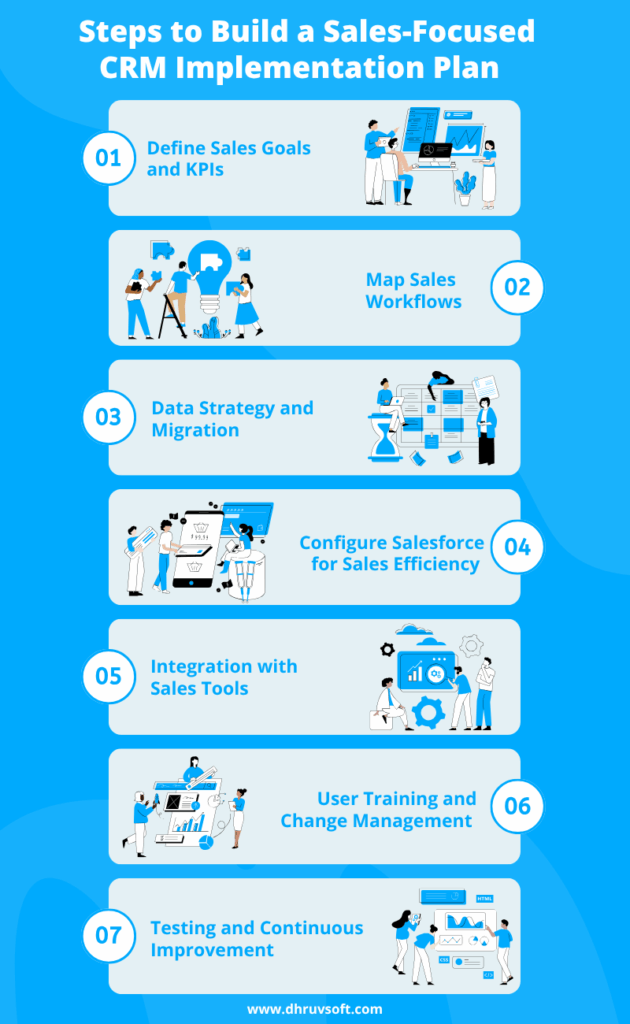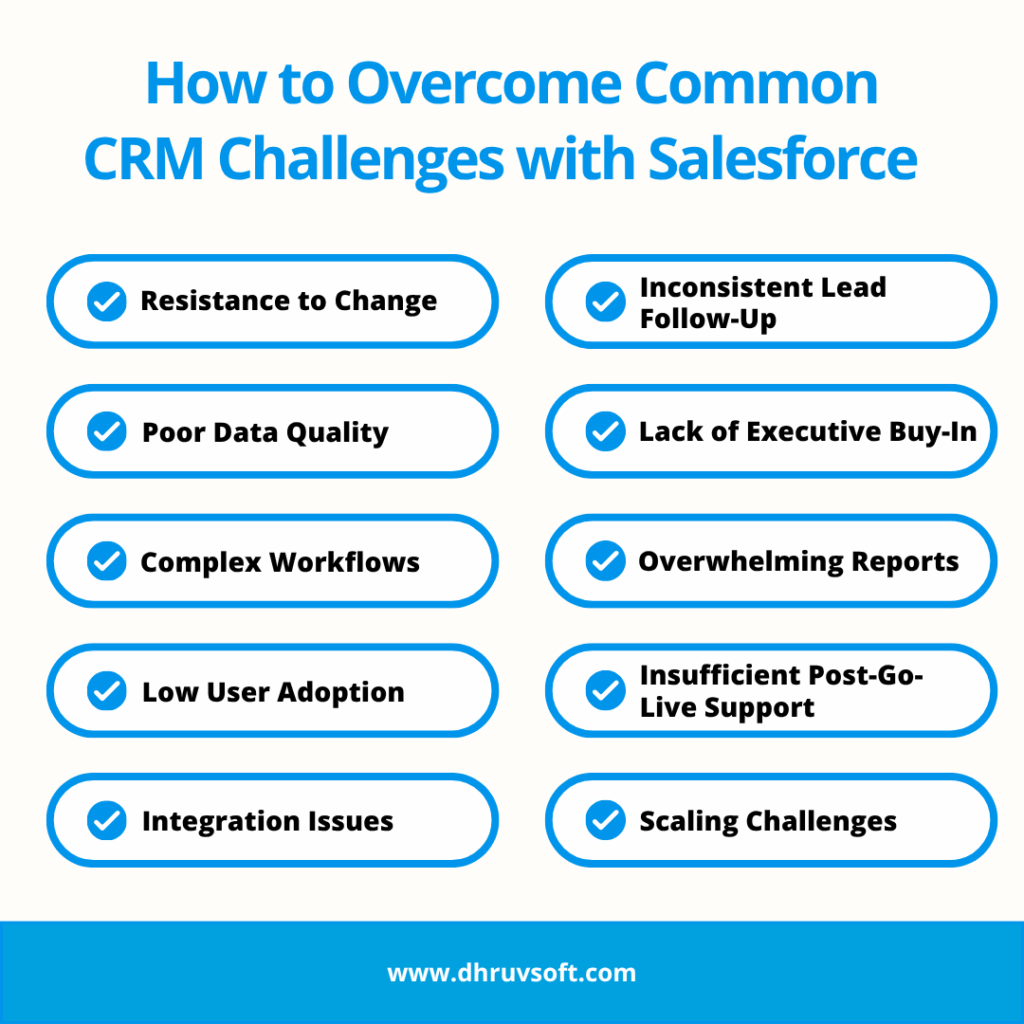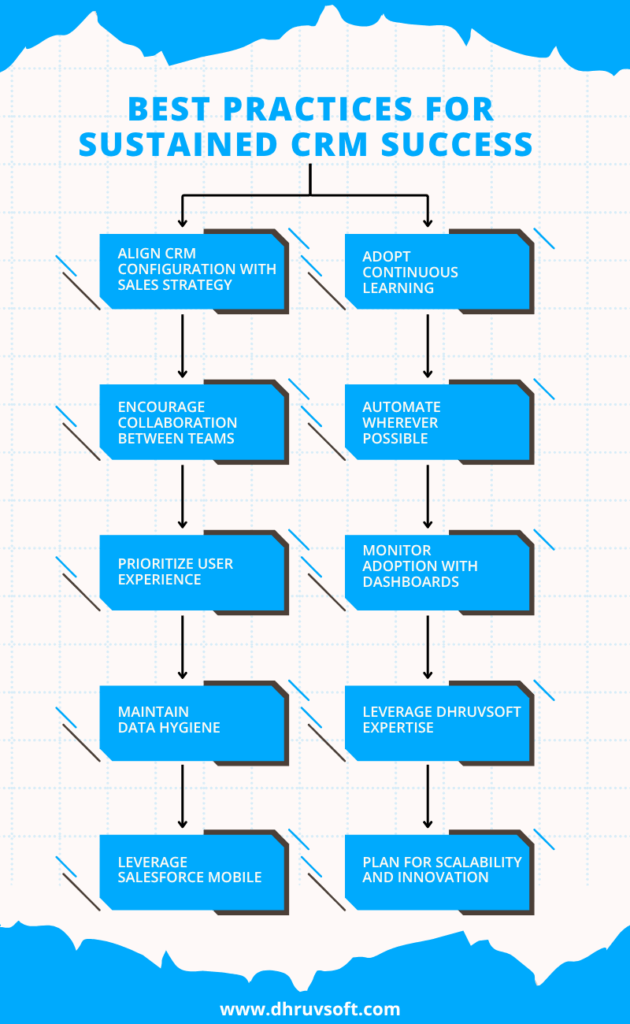
In today’s competitive business environment, boosting sales productivity and improving customer engagement is essential. A Salesforce CRM implementation allows businesses to streamline sales processes, track performance, and enhance collaboration across teams. However, simply installing a CRM system is not enough. Without a sales-focused CRM plan, organizations risk creating a generic system that fails to address the unique needs of their sales team.
By tailoring Salesforce to your sales workflows, you can improve lead response times, enhance pipeline visibility, and empower your team with real-time insights. A carefully planned implementation ensures your CRM for sales teams becomes an essential tool for driving revenue and long-term business growth.
Why a Sales-Focused CRM Implementation Matters
Sales teams operate differently from other departments. Unlike marketing or finance teams, which focus on campaigns or reporting, sales rely on speed, accurate forecasts, and efficient processes. A misaligned CRM setup can lead to delays, lost opportunities, and frustrated employees.
A Salesforce CRM for sales ensures that the platform meets the unique needs of your team. Key benefits include:
- Faster lead response times, ensuring no opportunity slips through the cracks.
- Enhanced pipeline visibility, allowing managers to monitor deal stages effectively.
- Improved forecast accuracy, helping leaders make data-driven decisions.
- Seamless collaboration between sales and marketing teams for a unified approach.
Implementing a sales-focused CRM plan transforms Salesforce into a tool that truly empowers your sales force rather than just being a system for data entry.
Understanding Sales Team Needs and Pain Points
A successful Salesforce CRM implementation starts with a clear understanding of the sales team’s challenges. Every organization has unique processes, and Salesforce’s flexibility allows you to address these pain points effectively.
Identifying Needs
To build a system that truly supports your sales team, it’s important to:
- Conduct interviews or surveys with sales reps, managers, and leadership
- Observe daily workflows to uncover inefficiencies
- Analyse historical sales data for recurring bottlenecks
Common Sales Pain Points
- Time-consuming data entry, which reduces selling time
- Lack of lead visibility, causing missed opportunities
- Poor integration with marketing and communication tools
- Difficulty tracking performance metrics and measuring results
Salesforce Solutions
- Sales Cloud offers a unified platform to manage leads, accounts, and opportunities.
- Einstein Activity Capture automates activity tracking to free up more selling time
- Pipeline Management ensures visibility into every deal stage
Mapping these pain points to Salesforce capabilities helps create a sales-focused CRM plan that supports the team rather than disrupts it.
Steps to Build a Sales-Focused CRM Implementation Plan
Creating a structured sales-focused CRM plan ensures success. Here’s how to approach it:
Step 1: Define Sales Goals and KPIs
Identify measurable objectives, such as win rates, deal velocity, average deal size, and customer retention. Align Salesforce dashboards with these KPIs to provide real-time insights that help reps and managers stay on track.
Step 2: Map Sales Workflows
Document your lead-to-close process and configure Salesforce to reflect actual sales stages. Automate repetitive tasks, such as lead routing and follow-up reminders, using Salesforce Flow and Einstein AI. This ensures that your CRM workflow automation aligns with real-world sales practices.
Step 3: Data Strategy and Migration
Clean and accurate data is the foundation of any CRM. Audit existing spreadsheets, legacy systems, and databases, then deduplicate and standardise records before migrating to Salesforce. Structured and reliable data ensures accurate reporting and better forecasting.
Step 4: Configure Salesforce for Sales Efficiency
Customize Leads, Opportunities, and Account objects to match your workflow. Use Salesforce automation tools to reduce manual work, increase productivity, and provide actionable insights through role-based dashboards.
Step 5: Integration with Sales Tools
Integrate Salesforce with essential tools like marketing automation platforms, email, calendar, and communication apps. Connecting legacy systems using MuleSoft or Salesforce APIs ensures a unified, 360-degree view of customers.
Step 6: User Training and Change Management
Train sales reps through role-based Salesforce Trailhead modules. Gamify CRM usage and recognize top performers to boost engagement. A strong change management plan ensures your sales team sees the CRM as a valuable tool rather than a burden.
Step 7: Testing and Continuous Improvement
Pilot the CRM with a small group, gather feedback, and optimize workflows before scaling across the organization. Continuous monitoring and improvement are essential to sustaining long-term adoption and maximising ROI.
How to Overcome Common CRM Challenges with Salesforce
Even with a well-structured sales-focused CRM implementation plan, sales teams often face challenges that can hinder adoption and reduce ROI. Salesforce provides a comprehensive suite of tools to tackle these issues and ensure that your CRM drives measurable business results.
Resistance to Change
One of the most common obstacles to CRM adoption is resistance from employees. Sales reps may fear new technology or perceive it as extra work. If users don’t adopt the system, even the most advanced Salesforce CRM will fail to deliver results.
Solution: Salesforce’s intuitive interface reduces the learning curve, and Trailhead, Salesforce’s interactive learning platform, allows users to acquire hands-on knowledge at their own pace. Role-based learning paths, gamification, and clear step-by-step guides make it easier for sales teams to embrace the CRM. When users see how Salesforce simplifies daily tasks rather than adds to their workload, adoption improves dramatically.
Poor Data Quality
Inaccurate or incomplete data can undermine the value of any CRM system. Duplicate leads, outdated contact information, or inconsistent records make lead scoring, forecasting, and reporting unreliable. Poor data quality also frustrates sales teams who spend time verifying records instead of selling.
Solution: Salesforce offers Duplicate Management tools and Data.com Clean capabilities that automatically detect duplicates, standardise records, and enrich contact information. By maintaining clean and accurate data, sales teams can trust the CRM, make better decisions, and improve conversion rates.
Complex Workflows
Over-customization or poorly designed processes can make Salesforce confusing and overwhelming. Sales reps may struggle to navigate multiple screens, fields, and objects, leading to errors and inefficiencies.
Solution: Salesforce Flow simplifies complex workflows by automating repetitive tasks and guiding users through processes step by step. By mapping workflows logically and reducing unnecessary complexity, Salesforce helps teams focus on revenue-generating activities instead of navigating complicated CRM menus.
Low User Adoption
Even when a CRM is technically perfect, low adoption rates can prevent organizations from achieving ROI. Sales reps may perceive the CRM as an administrative burden rather than a productivity tool.
Solution: Embed Salesforce into the daily routines of your sales team. Use Salesforce Mobile to provide access anytime, anywhere, and gamify CRM usage to motivate engagement. Leader-boards, badges, and recognition for high CRM activity create healthy competition and encourage consistent use.
Integration Issues
Sales teams rely on multiple tools such as marketing automation, email platforms, communication apps, and legacy systems. When these tools don’t sync with the CRM, data silos form, and the customer experience suffers.
Solution: Salesforce integrates seamlessly with other applications using MuleSoft or Salesforce APIs. This ensures real-time data synchronisation across all systems, giving your sales team a 360-degree view of customers and enabling better collaboration between departments.
Inconsistent Lead Follow-Up
Leads can slip through the cracks if there’s no systematic follow-up. Delayed responses or missed interactions reduce conversion rates and revenue potential.
Solution: Einstein Activity Capture and workflow automation in Salesforce ensure leads are automatically assigned, prioritised, and followed up on. Automated reminders, notifications, and lead scoring help sales reps focus on high-value prospects, ensuring timely engagement and improved conversion.
Lack of Executive Buy-In
Without leadership support, CRM initiatives often fail. Executives who are not engaged cannot champion adoption, allocate sufficient resources, or enforce accountability.
Solution: Involve senior sales leaders early in the CRM planning process. Salesforce dashboards allow executives to monitor KPIs in real-time, demonstrating the CRM’s impact on revenue and business growth. When leadership sees tangible results, they are more likely to support and promote CRM adoption throughout the organization actively.
Overwhelming Reports
Too many dashboards or poorly structured reports can confuse sales teams instead of helping them. If users can’t extract actionable insights quickly, CRM adoption and effectiveness suffer.
Solution: Einstein Analytics enables smart, actionable reporting that highlights key metrics without overwhelming users. Customizable dashboards focus on critical KPIs like lead conversion, opportunity stages, and sales velocity, allowing teams to make informed decisions quickly.
Insufficient Post-Go-Live Support
A CRM system is not a “set and forget” tool. Without ongoing support, processes can degrade, errors may go unnoticed, and user engagement can decline over time.
Solution: Plan for periodic Salesforce audits, performance reviews, and admin maintenance cycles. Dhruvsoft can provide continuous support to ensure configurations remain aligned with evolving sales processes, ensuring your CRM continues delivering value long after implementation.
Scaling Challenges
As your business grows, sales teams expand, and workflows evolve. A CRM that isn’t scalable can create bottlenecks, hinder performance, and fail to support new business processes.
Solution: Salesforce’s modular and scalable architecture allows organizations to adapt as they grow. Add new users, automate additional processes, or integrate new apps from AppExchange without disrupting existing workflows. This ensures your sales-focused CRM plan remains effective during periods of rapid growth.
By proactively identifying these common challenges and leveraging Salesforce’s capabilities, organizations can achieve higher adoption, better data accuracy, efficient workflows, and stronger sales performance. When combined with a well-designed sales-focused implementation plan, Salesforce becomes a true driver of business growth rather than just a data management system.
Measuring CRM Success for Sales Teams
Tracking the right metrics is essential to ensure that your Salesforce CRM implementation delivers measurable value and continues to support sales growth over time. A CRM is only as good as the insights it provides, and by focusing on key performance indicators, sales leaders can make data-driven decisions, optimize workflows, and maximize ROI.
Lead Conversion Rates
Lead conversion rates indicate how effectively your sales team is turning prospects into paying customers. Low conversion rates may highlight issues with lead qualification, follow-ups, or sales engagement strategies.
Salesforce Advantage: Using Sales Cloud, you can track each lead through the sales pipeline, measure conversion at every stage, and identify bottlenecks. Automated alerts and follow-up reminders help ensure no lead is neglected, improving overall conversion rates and sales productivity.
Average Sales Cycle Time
The average sales cycle metric measures the time it takes to close deals from initial contact to final sale or deal closure. Long cycles may indicate inefficiencies, such as slow response times, unoptimized workflows, or misalignment between sales and marketing.
Salesforce Advantage: With customizable dashboards and Einstein Analytics, managers can monitor cycle times for individual reps, product lines, or customer segments. Insights from these metrics allow teams to streamline processes, prioritise high-value opportunities, and reduce the time to close, increasing revenue velocity.
Forecast Accuracy
Accurate sales forecasting is critical for planning resources, setting revenue targets, and aligning business strategies. Inaccurate forecasts can lead to over-staffing, missed quotas, or poor decision-making.
Salesforce Advantage: Salesforce enables real-time tracking of opportunities, deal stages, and pipeline health. With predictive analytics and AI-powered insights from Einstein Analytics, sales leaders can generate more reliable forecasts, compare projected versus actual results, and adjust strategies proactively to achieve targets.
User Adoption Rates
Even the best CRM will fail if sales teams don’t use it consistently. Monitoring user adoption rates ensures that reps are engaging with Salesforce effectively, updating opportunities, logging activities, and leveraging automated workflows.
Salesforce Advantage: Salesforce dashboards can track login frequency, activity completion, and feature usage across teams. Low adoption rates can be addressed through targeted training, gamification, or by embedding CRM usage into daily routines via Salesforce Mobile.
Continuous Process Refinement
Tracking these metrics is not a one-time task—it requires ongoing attention. Managers should regularly review dashboard insights, identify trends, and make iterative improvements to workflows, automation rules, and reporting structures. A sales-focused CRM plan ensures that Salesforce evolves alongside your business, supporting growth, scalability, and stronger collaboration between sales, marketing, and service teams.
By leveraging Salesforce analytics, organizations gain actionable insights, optimize performance, and ensure that their CRM investment translates into sustained revenue growth.
Best Practices for Sustained CRM Success
Maintaining a successful sales-focused CRM plan requires ongoing attention, strategic alignment, and continuous improvement. A CRM system is not a one-time implementation; it evolves as your sales processes, team dynamics, and business goals change. Following these best practices ensures that your Salesforce CRM implementation continues to drive growth, adoption, and measurable ROI.
Align CRM Configuration with Sales Strategy
As your sales processes evolve, your CRM configuration must evolve alongside them. Align Salesforce workflows, opportunity stages, and dashboards with current business objectives to ensure the system supports revenue goals effectively.
Tip: Regularly review your KPIs, adjust automation rules, and optimize dashboards to reflect changing sales strategies. When the CRM mirrors real-world processes, reps find it intuitive and helpful rather than cumbersome.
Encourage Collaboration Between Teams
A siloed CRM limits insights and reduces efficiency. Integrating Salesforce’s marketing, sales, and service modules creates a unified platform that supports the entire customer journey from lead generation to post-sale support.
Example: Marketing campaigns tracked in Pardot can automatically feed qualified leads into Salesforce Sales Cloud. Customer service teams can access the same records, ensuring consistent communication and faster issue resolution. This integrated approach improves customer experience and boosts revenue.
Prioritize User Experience
A cluttered CRM can reduce adoption and frustrate users. Simplify layouts, remove redundant fields, and design intuitive dashboards that display only the most relevant information.
Tip: Use role-based dashboards so each sales rep, manager, or executive sees the metrics and tasks most relevant to their role. A system that’s easy to navigate increases engagement and helps teams focus on selling rather than managing data.
Maintain Data Hygiene
Data integrity is essential for accurate reporting, forecasting, and automation. Schedule regular data clean-ups and leverage Salesforce’s deduplication tools to prevent duplicate records and maintain consistency across the platform.
Tip: Automate data validation rules and standardisation processes where possible. Clean data ensures reliable analytics, improves lead scoring accuracy, and strengthens trust in the CRM among sales teams.
Leverage Salesforce Mobile
Field sales teams need real-time access to information to stay productive. Salesforce Mobile allows reps to update opportunities, log calls, and manage tasks on the go, ensuring no lead or deal slips through the cracks.
Example: A sales rep visiting a client can instantly check past interactions, log notes, and update deal stages, ensuring seamless communication with the office team and accurate pipeline tracking.
Adopt Continuous Learning
Salesforce is constantly evolving, and keeping your team up-to-date is critical. Encourage reps to complete Trailhead training modules regularly and participate in certification programs to maintain proficiency.
Tip: Gamify learning by awarding badges or incentives for completing advanced modules. Continuous skill development keeps teams engaged and ensures they effectively leverage all features of Salesforce.
Automate Wherever Possible
Repetitive manual tasks reduce selling time and increase errors. Leverage Salesforce Flow and Einstein Automate to automate routine processes, such as lead assignment, follow-up reminders, and reporting.
Benefit: Automation increases efficiency, ensures consistent execution of business rules, and allows your team to focus on higher-value activities like closing deals and nurturing relationships.
Monitor Adoption with Dashboards
Tracking CRM usage is essential to maintain engagement. Use Salesforce dashboards to monitor activity levels, identify inactive users, and detect low engagement regions.
Tip: Provide targeted training or support to underperforming teams. Recognizing high adoption rates through incentives also motivates consistent use across the organization.
Leverage Dhruvsoft’s Expertise
Regular assessments and expert guidance can uncover hidden inefficiencies and optimize your Salesforce instance. Dhruvsoft team provides Salesforce Health Checks and adoption assessments, ensuring your CRM remains aligned with business needs and supports maximum ROI.
Benefit: External expertise helps identify automation opportunities, optimize workflows, and ensure your sales-focused CRM plan continues to deliver measurable results.
Plan for Scalability and Innovation
A growing business requires a scalable CRM. Explore new Salesforce releases, AI enhancements, and AppExchange add-ons to expand functionality and stay ahead of competitors.
Tip: Continuously review emerging Salesforce tools and features that can enhance sales efficiency, predictive analytics, or customer experience. A scalable, innovative CRM ensures your system supports growth without disruption.
By implementing these best practices, your Salesforce CRM for sales teams becomes a long-term driver of business growth. Teams stay productive, data remains accurate, processes are optimised, and the organization continuously benefits from actionable insights, all contributing to higher adoption, improved efficiency, and stronger ROI.
Conclusion
A sales-focused Salesforce CRM plan transforms CRM from a simple tool into a strategic asset. By understanding your sales team’s challenges, customising workflows, automating processes, and investing in continuous training, your organization can achieve faster lead conversion, better forecast accuracy, and long-term business growth.
Partner with Dhruvsoft, Salesforce implementation experts, to design a CRM for sales teams that improves productivity, adoption, and revenue. With a well-executed Salesforce CRM plan, your sales team can focus on what matters most: closing deals and growing your business.


